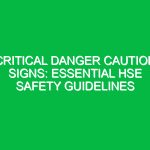Introduction
Culture Safety is a pivotal concept in the realm of Health, Safety, and Environment (HSE). It refers to the shared values, beliefs, and practices that influence how Safety is perceived and prioritized within an organization. A robust culture of safety fosters an environment where employees feel empowered to report Hazards, engage in safety practices, and contribute to continuous improvement. Understanding and implementing strategies to enhance culture safety is crucial for organizations aiming to minimize risks and ensure a healthy workplace.
In today’s fast-paced industrial landscape, the significance of culture safety cannot be overstated. Organizations that prioritize safety not only comply with Regulations but also cultivate a workforce that is more engaged, satisfied, and productive. This article delves into the essential strategies for unlocking culture safety, emphasizing its relevance to HSE success.
The Core Elements of Culture Safety
Understanding the core elements of culture safety is fundamental to developing effective strategies.
1. Leadership Commitment
Strong leadership is the cornerstone of an effective safety culture. Leaders must demonstrate a commitment to safety, not just through words but through actions. This includes allocating resources for safety Training, participating in safety meetings, and visibly prioritizing safety in all operational decisions. When employees see their leaders prioritizing safety, they are more likely to adopt similar attitudes.
2. Open Communication
Encouraging open lines of communication is vital for establishing culture safety. Employees should feel comfortable reporting unsafe conditions or behaviors without fear of retribution. This openness fosters trust and encourages proactive engagement in safety discussions. Regular safety meetings and anonymous reporting mechanisms can facilitate this communication.
3. Employee Empowerment
Empowering employees to take ownership of safety promotes a proactive culture. This can be achieved by involving employees in safety committees, encouraging them to participate in risk assessments, and seeking their input on safety Procedures. When employees feel valued in the safety process, their commitment to maintaining a safe work environment increases.
4. Continuous Learning and Improvement
A culture that emphasizes continuous learning recognizes that safety practices must evolve. Regular training sessions, workshops, and drills help reinforce safety knowledge and skills. Additionally, organizations should conduct regular safety audits and reviews to identify areas for improvement. Sharing lessons learned from incidents, whether minor or severe, is also crucial for fostering a learning environment.
5. Recognition and Rewarding Safe Behaviors
Recognizing and rewarding employees for safe behavior is an effective method for reinforcing culture safety. Implementing incentive programs for teams that achieve safety milestones or have an exemplary safety record can motivate others to prioritize safety. Simple acknowledgments during meetings or company-wide shout-outs can also enhance morale and encourage Safe Practices.
Implementing Culture Safety Strategies
To unlock culture safety effectively, organizations must implement structured strategies that align with their specific operational contexts.
1. Conduct a Safety Culture Assessment
The first step in improving culture safety is assessing the current state of safety culture within the organization. Surveys and interviews can provide valuable insights into employee perceptions of safety and areas that require enhancement. Tools such as the Safety Culture Assessment Tool (SCA) can help organizations gather data and identify gaps.
2. Develop a Comprehensive Safety Program
A comprehensive safety program should encompass policies, procedures, and training that align with the organization’s goals. This program should be adaptable to changing circumstances and should integrate feedback from employees at all levels. Regularly revisiting and revising the program ensures it remains relevant and effective.
3. Foster a Safety-First Mindset
Creating a safety-first mindset requires consistent reinforcement of safety values. This can be achieved through onboarding programs for new employees that emphasize safety practices and expectations. Furthermore, ongoing training and reminders about the importance of safety can help embed these values into the organizational fabric.
4. Engage in Incident Investigation and Root Cause Analysis
When incidents occur, conducting thorough investigations is essential for understanding the underlying causes. This process should involve all relevant stakeholders, including employees who were directly involved. Identifying root causes not only prevents recurrence but also demonstrates a commitment to learning and improvement.
5. Leverage Technology for Safety Management
Technology can play a significant role in enhancing culture safety. Utilizing software for tracking safety incidents, training compliance, and employee feedback can streamline processes and improve accountability. Wearable technology, such as safety helmets with built-in sensors, can also provide real-time data on environmental conditions, helping to mitigate risks proactively.
Potential Hazards and Risks Related to Culture Safety
While fostering a strong culture of safety is essential, organizations must also be aware of potential hazards and risks associated with neglecting culture safety.
1. Increased Incidents and Accidents
A weak safety culture often leads to a higher incidence of workplace accidents. When employees feel they cannot report unsafe conditions or do not believe that management prioritizes safety, they may ignore hazards, leading to increased risks.
2. Low Employee Morale and Engagement
An organization that does not prioritize culture safety may experience low morale among employees. This can result in disengagement, increased absenteeism, and higher turnover rates. Employees who do not feel safe are less likely to be productive and committed to their work.
3. Legal and Financial Repercussions
Failure to address culture safety can expose organizations to legal liabilities and financial penalties. Regulatory bodies enforce strict safety Standards, and non-compliance can result in fines, lawsuits, and damage to the organization’s reputation.
Regulations and Standards in Culture Safety
Understanding the legal and regulatory framework surrounding culture safety is essential for compliance and effective management.
1. Occupational Safety and Health Administration (OSHA) Standards
In the United States, osha sets forth regulations that govern Workplace Safety. These standards require employers to provide a safe working environment, which includes fostering a positive safety culture. Organizations must comply with these regulations to avoid penalties and ensure employee safety.
2. International Organization for Standardization (ISO) Standards
ISO standards, such as ISO 45001, focus on Occupational Health and safety management systems. This standard emphasizes the importance of leadership and worker participation in establishing a culture of safety. Organizations that adhere to these standards benefit from improved safety and operational performance.
3. Industry-Specific Regulations
Many industries have specific regulations that pertain to safety culture. For instance, the oil and gas industry is governed by the Process Safety Management (PSM) standard, which requires organizations to implement safety management systems that include cultural elements. Understanding and adhering to these regulations is crucial for organizations operating within these sectors.
Conclusion
Unlocking culture safety is essential for achieving Health, Safety, and Environment (HSE) success. By fostering a strong safety culture through leadership commitment, open communication, employee empowerment, and continuous learning, organizations can mitigate risks and enhance overall Workplace Safety. The integration of technology, adherence to regulations, and a focus on continuous improvement further reinforce the importance of culture safety.
As organizations strive to create safer work environments, it becomes imperative to recognize that culture safety is not merely a compliance issue but a fundamental aspect of organizational health. By prioritizing culture safety, companies can not only protect their employees but also foster a more engaged, productive, and resilient workforce. The journey toward a robust culture of safety begins with a commitment to continuous improvement and a dedication to the well-being of every individual in the organization.


